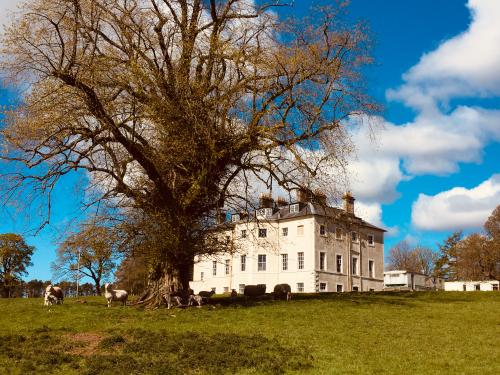Digging into the Problem: AMR in Agricultural Ecosystems
The use of antimicrobials in livestock farming has proven essential for maintaining animal health, but are known to contain resistant bacteria due to the use of antimicrobials in livestock. As bacteria become resistant to these treatments, they can spread resistance genes into the wider environment when animal manure or slurry is used as fertiliser. Antimicrobial resistance may persist in the soil for long period of time, increasing the risk of transferring these genes to soil microbiota as well as to animal and human pathogenic bacteria. This occurs through the ability of bacteria to acquire resistance genes by horizontal gene transfer, that is, by movement of genetic material between bacteria by means that are not reproduction.
AMR and Farm Practices (Illustration by Joana Silva)
So, What About use Biosolids as a Fertiliser?
Biosolids, derived from treated sewage sludge, contain organic nutrients that can be used to enrich soils. The sludge is transformed into biosolids through two main processes: the physical removal of a significant portion of water and the biological reduction or elimination of pathogens. As a result, the biosolids generated may be used on land applications (crops lands, grasslands and forest) providing a range of nutrients to the soil. They sound like a good alternative to animal manure, right? But wait - biosolids can also harbour resistance genes just like manure and slurry, that could persist for extended periods in soil and the environment and increase the risk of development of AMR.
Comparing Fertilisation Practices- What We’re Learning So Far
Our research aims to compare whether the application of farmyard manure, slurry, and biosolids have different effects on the abundance of AMR genes and resistant bacteria in the agricultural ecosystem by testing the pasture soil, animals that graze on it and the surrounding water bodies. This project extends our prior research to assess the impact of biosolid application on the abundance of antimicrobial resistance genes in soil. To explore this, we have analysed two fields, one fertilised with biosolids, and the other with the old-fashioned inorganic fertiliser. Early results? So far, data revealed no statistically significant differences in the abundance of resistance genes before and after biosolids treatment or between the two fields.
Animal grazing in pasture treated with farmyard manure on Firth Mains farm (Credit: Nuno Silva)
Other key areas of investigation include:
Tracking AMR Spread
This includes investigating how AMR bacteria and the resistance genes they contain move from applied biosolids, slurry and farmyard manure into the soil, water systems and animals. Each fertilisation practices has its peculiarities, and we want to figure out which one might be driving the greatest risk of AMR in different ecosystems.
Analysis of antimicrobial and heavy metal residues
We aim to assess whether low concentrations of antimicrobials and heavy metals can be detected in samples of soils treated with farmyard manure, slurry, and biosolids, and whether these concentrations are different to control sample (untreated soils). Any such compounds present in soil can exert a selective pressure, creating conditions where resistant bacteria thrive leading to the development and persistence of AMR in agriculture systems.
Prevalence and transmission of resistant bacteria in livestock farms
This are of investigation includes evaluating the impact of farming systems on bacteria circulating within the farm environment. We are also analysing the prevalence of AMR bacteria within the commensal microbiota (the beneficial microorganisms naturally living in animals) of animals grazing on pastures treated with different fertilisers. Whole-genome sequencing (WGS) will be used to further characterize the most promising bacterial isolates. Determining the presence of multiple resistance genes in individual bacterial isolates, and the presence of the same resistance genes in unrelated bacterial species will provide important information on the role of the animal microbiota in the flow of AMR within the farm environment.
Water sample processing in the laboratory (Credit: Nuno Silva)
We need a team - A Collaborative Approach
Over the last 2.5 years, we have established a management plan for the application of different organic fertilisers (biosolids, farmyard manure and slurry) in consultation with Biomathematics and Statistics Scotland (BioSS) and defined the experimental protocols for sampling. Additionally, our collaboration with BioSS, based on their work on Large-scale and Systems Modelling, aims also to contribute with specific data in the development of a Foodborne Antimicrobial Resistance risk model.
We have sampled soil, animal faeces, water, and sewage from treated fields. A total of 900 soil, 360 faecal, 108 water, and 6 sewage samples were collected. We have isolated Escherichia coli, an indicator of AMR, from these samples, using the "breakpoint" plate method to assess resistance to three antimicrobials. Additionally, our colleagues at The Rowett Institute have isolated several obligately anaerobic bacterial species resistant to multiple antimicrobials from sheep faeces, with several novel strains identified.
The project's findings have been shared at several important events to inform scientists policymakers and public. The team has been engaging with stakeholders through workshops and symposiums to address antimicrobial resistance (AMR) in agriculture to promote sustainable agricultural practices to reduce AMR risks, including the Royal Highland Show (2023-2024), Cochno Farm Open Day at the University of Glasgow, and the RESAS Science, Evidence, and Policy Conference 2023, among other events.
Glasgow University's Cochno Farm open day, June 2023 (Credit: George King).
For more information, visit the project page.
Written by Dr Nuno Silva (Moredun Research Institute), Prof Karen Scott (The Rowett Institute) and Dr Glenn Marion (BioSS)
